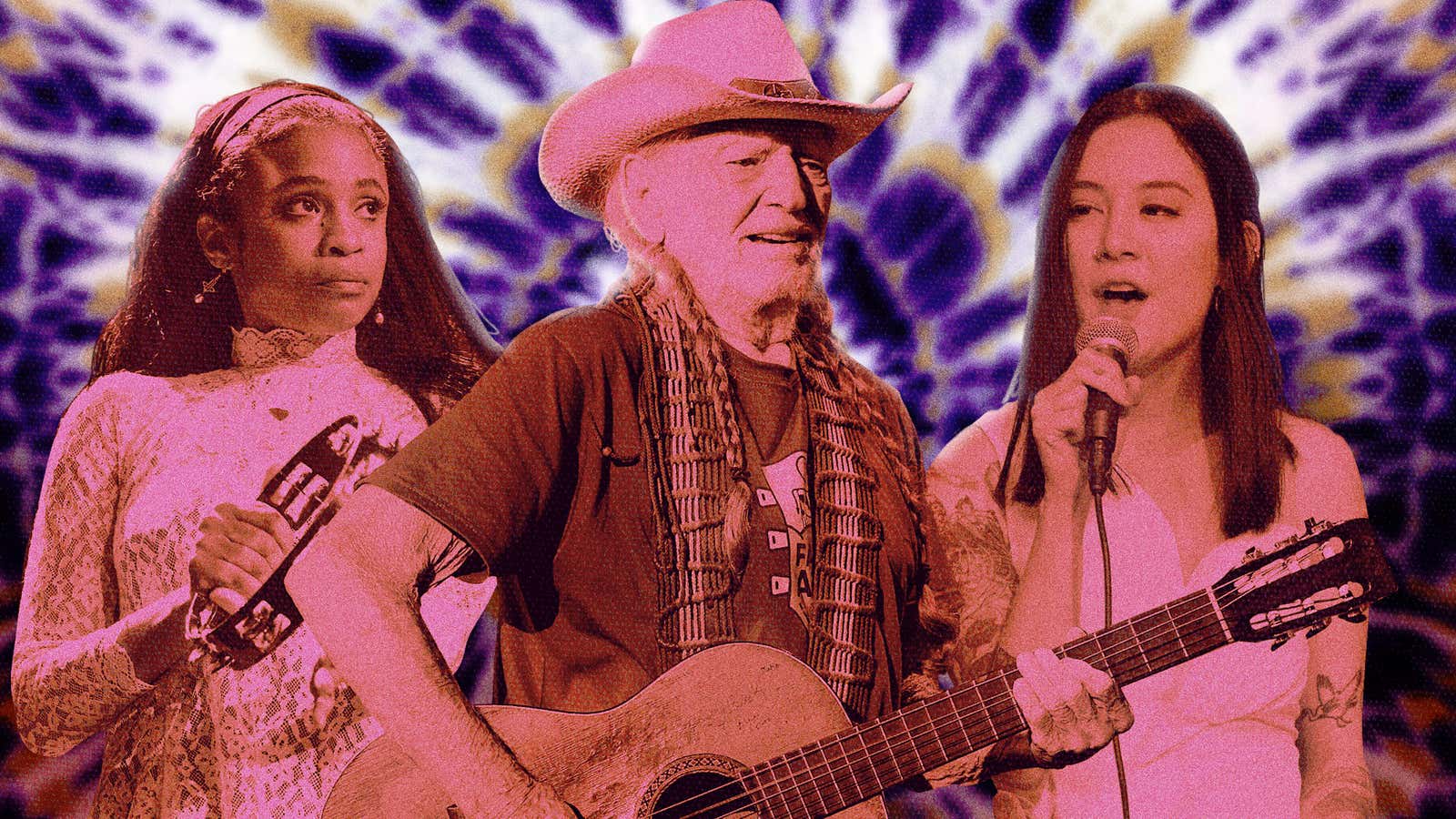Thursday, March 17, 10:45 P.M.
Uh oh. I’m high.
Through no fault of my own, I should hasten to add. Okay, that’s not entirely true: It’s a little bit my own fault. See, I am not especially good at resisting the pull of peer pressure. As a child, when your parents would sternly ask, “If all of your friends jumped off of a bridge, would you, too?” I was always the one already falling halfway to the ground from the bridge, saying, “Wait, there was a choice?”
And in this case, the choice seemed inevitable. It’s the closing minutes of Willie Nelson’s 10th anniversary Luck Reunion, held on his personal compound in Luck, Texas, and the Red-Headed Stranger has taken the stage for his headlining set, bracketed on either side by his two sons, all strumming away on their guitars. And when the band launches into the recent tune, “If I Die When I’m High I’ll Be Halfway To Heaven,” every single person in my immediate vicinity lights up, and starts passing the joints around. Every. Single. Person. (Well, maybe not the 6-year-old spinning around on his parents’ picnic blanket behind me, but you get the idea.) I’ve been here for 12 hours, the finish line is in sight, and I’m exhausted, so after the fourth time I politely demur, the taller half of a lesbian couple right next to me drapes her arm over my shoulder and says with an affectionate drawl, “A little bit of weed?”
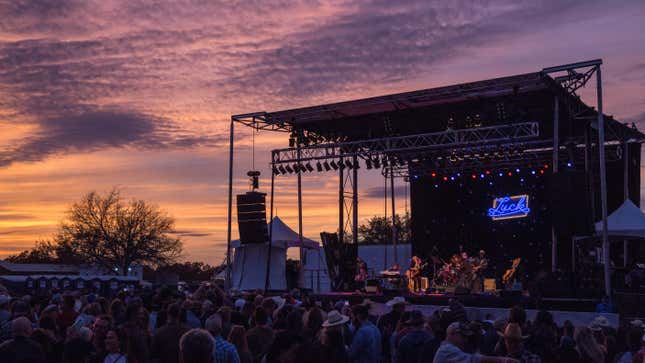
Hell, why not, I figure. I’ve earned it, my job here is now complete, and I’ll be heading out soon. (Also, it’s worth noting that I am not any kind of pot expert, as has been well-documented.) Roughly four minutes later, I realize what any sane person would have already put together in that situation: The weed being passed around shortly before midnight at Willie Nelson’s Luck Reunion fest is not normal human weed. This is marijuana expressly designed to make your soul leave your body and join Willie on stage. I only took three hits, but the results are simple: This may not have been the best decision. Still, at Willie Nelson’s family festival, surrounded by happy, loving strangers, was there really a choice?
The daylong fest known as Luck Reunion began exactly 10 years prior, in the spirit of fashioning a celebration of the culture and ethos Willie Nelson has long cultivated in his audience. In other words, progressive, open-minded, friendly, and proudly—almost aggressively—Southern. It’s focused on country and roots/Ameriana music (with some notable exceptions; paging Japanese Breakfast shortly), with an admirable blend of longtime legends and new-school up and comers mixing freely on five different stages—and extremely unique ones, at that.

The idiosyncratic layout of the grounds and performance areas is a story in its own right. After a small one-street set was built in 1986 as the backdrop for the Western Red Headed Stranger (based on Nelson’s classic concept album), the musician requested that he be allowed to purchase the property—fake buildings and all—rather than have the production company simply tear it all down. Nelson took the place, roughly an hour outside of Austin, Texas, and turned it into a proper one-horse town of sorts, complete with chapel, saloon, and a big old barn.

Walk around during Luck Reunion and you’ll see compelling sights in all of these places. Over there is a folk singer, performing for 50 people inside the tiny chapel. Stroll on past it, you’ll find a revival tent, jam-packed with folks swaying to the sounds of a country blues band. Stop by the beer garden, you’ll catch a pair of artists swapping guitars and telling stories as the crowd exhorts them on in the afternoon sun. And on the main stage, of course, you’ll see a steady progression of some of the best acts on hand, from honky-tonk to pop to Willie himself. Best of all, this is a family affair of sorts: Limited to just a shade over three thousand people, it’s the most intimate gathering you can imagine still being called a big music festival.
But more importantly, Luck Reunion represents something profound, even to my jaded eyes as an official Skeptical Midwest Culture Critic™ whose job at The A.V. Club for most of the past decade has involved attending odd little events like these and making fun of them. Here’s a large gathering of people who come together and sit peaceably, happily even, across lines political, cultural, and aesthetic, with the sort of live-and-let-live tolerance many of us were raised to believe was a bedrock of society. Unlike, say, Lollapalooza, there’s no drunken fights, no sense of look-at-me, Insta-ready solipsism among the attendees; just a sense of welcoming familial atmosphere. More than once, I witness strangers offer each other beers, high-fives, even hugs—rednecks, soccer moms, and gutter punks joined in communion.
Hell, even the several corporate sponsors seem to have the courtesy to lay off any intrusive advertising or product-placement that might kill the vibes. Luck Reunion is something special, in other words, an outpost of old-school liberalism—in the classical sense of the word, not the current political designation—that encourages a sensibility of fundamental neighborly decency. People actually pick up after themselves, here. Isn’t this the kind of festival we’d all prefer? The kind of community we’d all prefer? (The majority of us, anyway: for all the diversity of opinion, political and otherwise, I see emblazoned on T-shirts and novelty hats throughout the day, there’s a marked absence of MAGA apparel.)
9:56 A.M.—Austin, TX
I’m nestled into the window seat of a large passenger bus, rapidly filling up with a cross-section of America that, while largely white and middle-aged, nonetheless exudes the enthusiasm of a group of tweens waiting outside BTS’ hotel. There are occasional hoots and hollers, and a cowboy hat on roughly every fifth person. These are the shuttles that will be ferrying us from Austin out to Willie Nelson’s compound; plenty of others drive themselves, but as with many a festival, those in the know are wiser than to think they’ll be in any shape to drive home at midnight.
A gentleman in a vest and awkwardly fitting cowboy hat claims the spot right next to me. Seeing how quickly so many of the Willie enthusiasts start chatting up anyone in their immediate vicinity, I’m thrilled to discover my seatmate is as taciturn as I am. God bless you, fellow social introvert.
Approximately an hour later, we pull into Willie’s compound. (I don’t like using celebrities’ first names in such a casual way—we’re not friends, any more than the people at Entertainment Tonight are buddies with “Lin-Manuel”—but I’m not writing out his full name each time, and I’m certainly not about to sound deeply unstable by calling him “Nelson.”) Winding our way past the security gate, we join a lengthy caravan of cars making its way through dust-dappled pastures. A solitary horse, munching on some hay, silently greets us as we pass by, everyone on the bus oohing and ogling it when we pass it, as though we’ve never seen a horse before. To be fair, it’s possible none of us have ever seen a horse owned by Willie Nelson before, but still, it’s not like the thing is strumming a guitar.
11:10 A.M.
I walk through the entrance, and it is… a little overwhelming, honestly. It’s genuinely as much a solitary block of old-time country town as it is festival grounds. There’s already a honky-tonk bar band wailing away in the saloon. Besides the aforementioned chapel and revival tent, there’s a little country store selling a bunch of Willie-branded goods, the food court limned with trucks proffering both meat and meatless comestibles, a tarot reader, and much more. I start to catalogue everything, then quickly realize it’s a fool’s errand, not just because of the voluminous amount of local merchants plying their wares (everything from vintage cowboy clothes to lithographs and Tin Type photography), but because it would bore the shit out of you.
However, I’ve been up since seven, so it’s food truck time. After grabbing a taco (the only food truck that already has a line, which is what happens when you’re selling $6 tacos right next to a truck offering $19 lobster rolls), I stop to have my aura read by a woman who, after strapping my hands to sensors and snapping a polaroid, tells me all the violets and blues surrounding me suggest I’m strong in emotional intelligence. I find auras and tarot and astrology to be horseshit, so maybe she’s wrong? Nonetheless, the aura picture she takes makes me look less dorky than usual, so I like it.
12:40 P.M.
It’s a genuinely fascinating mix of people in this crowd—southern cowboy types, suburban hausfraus, hoodie-wearing hipsters, and—most noticeably—people clearly playing cowboy cosplay in the shiniest ensembles imaginable. Age-wise, it’s probably the most diverse festival crowd I’ve ever seen. Racially, not so much: It’s almost blindingly white. The lineup of artists performing is a hundred times more diverse than its audience.

I make my way over to the Revival Tent as Danielle Ponder takes the stage. (Yes, it’s a throwback revival tent, set up with poles and rope and whatnot.) You know when you see someone almost embarrassingly talented? Like, so charismatic and potent that you almost avert your eyes, “we’re not worthy”-style? Yeah. Everyone in the tent seems to instantly recognize Ponder as the real thing—seriously, you could hear a roach hit the dirt between songs. Even the hipster guy in an unbuttoned Hawaiian shirt, braying loudly in the back of the tent about NFTs, is temporarily cowed into silence by the force of her performance.
I can only surmise the reason she’s not at the top of every “Best New Artist” list at the moment is because her debut album hasn’t actually come out yet. Her version of old-school soul mixed with new-school grooves is masterful, and her voice achingly moving. Let’s meet back here at the end of the year, and see if she’s become as ubiquitous as I predict.
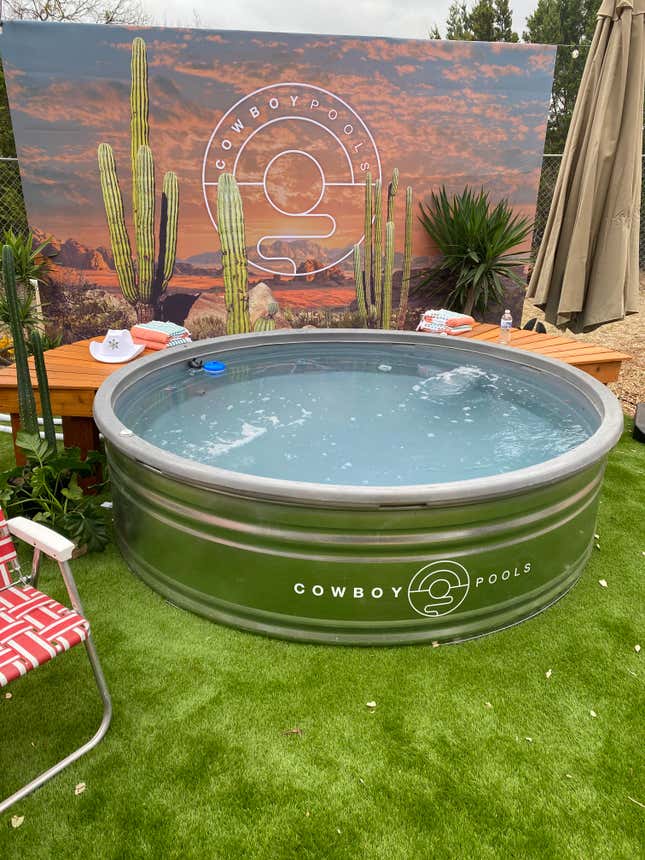
Afterwards, I decide to take a pass through the V.I.P. section, and after the earnest purity of everything about this event, am weirdly relieved to discover that even Willie Nelson’s homebrew version of a festival isn’t immune to the presence of self-important fashionista “influencers.” One woman has paired an elaborate cape with a dress a Batman villain would envy. There’s a heated (cowboy) pool, and a place where you can grab a Gibson guitar and strum a few chords if you’d like. And, of course, a lonely and unused bean-bag toss—the copper penny of any festival. Just for fun, I check back in on the bean bags every hour or so. They never move from the position in which I first saw them.
3:05 P.M.
Now that the festival grounds are really starting to fill up, what initially felt charming—hyper-specific little venues in which to watch artists perform intimate sets—is rapidly getting frustrating. My efforts to watch Adia Victoria’s superb-sounding set in the chapel are thwarted by the fact that the place holds like a few dozen people, tops. Meaning, the rest of us are desperately peering through windows into a lightless, shadowy room, like the world’s least subtle peeping toms. The sounds of her excellent blues stylings emanate, though, so I’ll just have to take it on faith that it’s coming from Victoria herself, and not a doppelgänger, or possibly a jukebox. No one else seems to mind, but then again, everyone else looks like they’re on at least their second White Claw by now.

3:40 P.M.
My shameful food cravings get the best of me, and I break down and order one of the aforementioned lobster rolls. It is the best money I will spend this entire trip. I am thinking about it still.
4:15 P.M.
“I’m sorry. I’m doin’ an interview here.” I’m strolling through the festival grounds with S.G. Goodman, who just finished an astonishing set on the main stage, one rich with new songs from her forthcoming album, Teeth Marks. A passerby has accosted her, wanting to tell the musician how great her set was (the person isn’t wrong), but Goodman politely explains she’s otherwise occupied—though not before offering a thank-you and head nod borne of first-rate manners. You want authentic country? S.G. is authentic as fuck—raised on a rural Kentucky farm, still lives in a nearby small town, plays a blend of rootsy folk riven through with seething indie-rock potency—which, along with her laconic country accent, makes her presence at Luck Reunion feel more earned than most, not that she cares about evaluating anyone’s credibility.
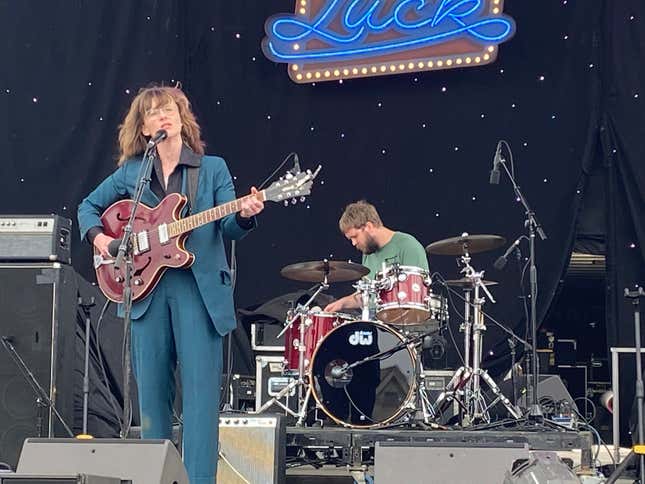
“That fella there, he’s dressed like he just came from plowin’ the fields all day, but he might’ve never set foot on a farm,” she says, gesturing towards one of the dudes I had earlier clocked as “cowboy cosplay.” “But it doesn’t matter; the people here all seem like they’re here for the music. I mean, I haven’t seen a single person thrown out for fighting. That’s really somethin’.” This generosity of spirit makes me like her immediately, something that often happens when I meet someone who is much nicer than me.
Goodman embodies everything awesome about this festival. Dressed like a cross between Patti Smith and an especially stylish extra from Robert Altman’s Nashville, she holds court on a variety of topics, from having supportive parents who also don’t really understand what you do for a living (“They’re good country people; I don’t think I’m the only one”) to her previous unique experience with Luck fest (several years ago, she bluffed her way into the Reunion by pretending to be the tour manager for Courtney Marie Andrews, who was performing). And after two years of a pandemic that took a heavy toll on everyone who depends on touring for their livelihood, she mostly feels gratitude. “I find it very funny that a girl from a town of less than 3,000 people is sitting here, and just watched Willie Nelson walk up on stage, when her Grandmama used to play his records. I mean, my father’s a farmer… everything I do, I’m carvin’ out the places in the world that were meant for them.”
As we wander the grounds, chatting about our respective home lives and sizing up the various other performance areas in comparison to her main-stage set (she admits to a twinge of jealousy at those who get to play the chapel), it strikes me that the dividing line between artist and audience at festivals is almost never this loose. The organizers of Luck Reunion, the artists playing, the fans attending—they all seem to share the goal of creating something special, away from the prying eyes of the mainstream, or other festivals’ desire to max out audience size and advertising in the pursuit of as much cash as possible, regardless of how it waters down the experience. When Goodman eventually departs in search of food, she’s not whisked away into a waiting cart, but rather ambles off to find the best meal, wherever it may be. Luck Reunion is a process of discovery, not a detailed map. (I’m being literal—good luck finding a detailed map.)
6:25 P.M.
After managing to squeeze into the chapel to catch the back half of Tré Burt’s set (if you’re wondering who inherited the “Dylan before he went electric” mantle of an artist who elevates nothing but an acoustic guitar, a harmonica, and his voice into a work of art, do yourself a favor and check out Burt), I take a moment to sit, something I’ve gotten to do precious little of today. Starting in about an hour, there will be nonstop music I’m eager to catch, and I want to plan out my night. It’s still light out, but people are settling down, spreading out their blankets are prepping for the night.
A little after sunset, I’ll watch Japanese Breakfast take the main stage, Michelle Zauner festively dressed and repeatedly describing the band’s sense of excitement at their first Luck Reunion performance. Her forward-thinking pop music is light years away from the majority of the artists playing today, but the crowd welcomes her like a long-lost relative.
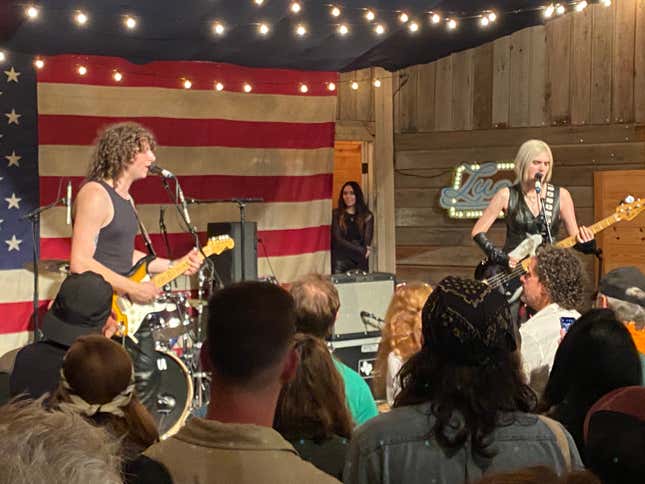
Immediately following that, I’ll slink my way into the limited capacity of the saloon, where I’ll see Sunflower Bean absolutely destroy an audience of maybe a hundred people, tops. As with Japanese Breakfast, the group delivers a set of music that couldn’t be further from the Southern-fried roots-rock that dominates every stage (Bean’s new music is the most ass-kicking indie-rock of its career, though the band offers an olive branch by playing “I Was A Fool,” which at least enters Fleetwood Mac territory); but everyone in attendance takes to it as though this were a headlining set at Pitchfork. Which, given how good they are, maybe next year it will be.
And then, after a “surprise” set by Jason Isbell & The 400 Unit (anyone who glanced at a small, handmade list of set times hung on the side of a barn near the Beer Garden learned of the appearance well in advance), Willie Nelson will take the stage. He’ll deliver a charming and occasionally ramshackle set, interspersed with loving family anecdotes and musical asides. He remains seated throughout—the man’s almost pushing 90, for god’s sake—but the crowd moves for him, a communal back-and-forth that travels from stage to ground and back again.
His set will again impress on me the unique nature of Luck Reunion, and what it means outside the world of this little time and place. It’s a reminder that we shouldn’t always settle for experiences and situations dictated by others who may have no regard for what we find special, or simply resign ourselves to always accepting the grimly capitalistic ideology that tells us profit dictates all. The “You’ll take your Ameritrust/PepsiCo/Merril Lynch Enormodome Fun Fest parking ticket, and you’ll be grateful for the opportunity to be allowed our branded ‘activation’, plebian” mindset need not always carry the day. Sometimes, just enough is more than enough, if it’s important to you. Here is a yearly demonstration of doing something because it’s meaningful, not remunerative. Don’t let the tools and herbs of the world grind you down, Luck Reunion seems to say: Find something better.
Even if it means you occasionally end up way too high.
